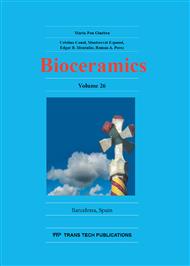p.269
p.275
p.283
p.289
p.295
p.300
p.306
p.315
p.321
P19.CL6 Cells Cultured in Apatite-Fiber Scaffold Differentiate into Cardiomyocytes
Abstract:
In the present study, we used an apatite-fiber scaffold (AFS) to culture P19.CL6 cells three-dimensionally. AFS was originally developed to use for the bone substitute and has high porosity and complex pore structure. The highly porous structure of AFS suggests it may be compatible for the in vitro reorganization of soft tissue. We previously showed the formation of small cell aggregates in AFS, and that culture in AFS increased the expression of cardiac-specific gene markers without the need for any inducing agent such as DMSO. However, it is difficult to evaluate the physiological function of cells in three-dimensional culture. In this study, we transformed P19.CL6 cells with the pTnnt2::GCaMP5G vector and observed the cells by fluorescence microscopy. pTnnt2::GCaMP5G consists of green fluorescent protein (GFP) fused with the Ca2+-sensitive domain of calmodulin; its expression is driven by a cardiomyocyte-specific promoter. We observed that the blinking of green fluorescence was synchronized to the beating of cardiomyocytes when the P19.CL6 cells were cultured in a dish, but blinking was not observed when the cells were cultured in AFS, even after 16 days. The expression of connexin 43 (Cx43) and enhanced Green Fluorescence Protein (EGFP) was examined by reverse transcriptase-polymerase chain reaction (RT-PCR). Cx43 is a gap junction protein expressed in cardiomyocytes that mediates cell-to-cell coupling. Although the expression of Cx43 and EGFP in transformed cells cultured in AFS was evident, fluorescence blinking of the cells was not observed. The results demonstrate that P19.CL6 cells cultured in AFS rapidly differentiated into early stage cardiomyocytes; however, additional modifications or developments are needed for further differentiation.
Info:
Periodical:
Pages:
295-299
Citation:
Online since:
November 2014
Authors:
Keywords:
Price:
Сopyright:
© 2015 Trans Tech Publications Ltd. All Rights Reserved
Share:
Citation:


